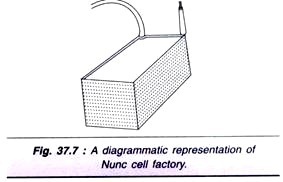ADVERTISEMENTS:
In this article we will discuss about:- 1. Meaning of Transposition 2. Mechanism of Transposition 3. Genetics.
Meaning of Transposition:
The phenomenon of moving genetic segments from one location to the other in a genome is known as transposition. There are two types of transposition, replicative and conservative transposition.
The replicative transposition involves the events of both replication and recombination processes generating the two daughter copies of the original transposable elements, one remaining at the parental site and the other at the target site.
ADVERTISEMENTS:
In addition, the conservative transposition does not involve replication. Simply the elements move to a new site. When the target site is present within a gene both types of transposition takes place. The frequency of transposition varies among different elements.
The overall rate of transposition is 105 -104 per element per generation. Different IS elements contain different number of bases. The elements contain at least two apparent coding sequences initiated by an AUG and termination with an in-phase stop codon.
Mechanism of Transposition:
The bacterial transposon Tn3 has been extensively studied. Analysis of DNA sequences and its junction with target DNA provides some clue to the mechanism of transposition.
Movement of transposons occurs only when the enzyme transposase recognises and cleaves at either 5′ or 3′ of both ends of transposon, and catalyses at either 5 or 3′ of both ends of transposon and catalyses a staggered cut at the target site (Figs. 8.30 and 8.34A). Depending on transposon, a duplication of 3-12 bases of target DNA occurs at the site where insertion is to be done. One copy remains at each end of the transposon sequence.
ADVERTISEMENTS:
After attachment of both ends of transposon to the target site, two replication forks are immediately formed (Fig. 8.34 B-C). From this stage there starts two path for carrying out onward processes. The first model is the replication path where the transposon replicates and the replicated DNA sealed to flanking sequences generating a co-integrate (D).
Co-integrate is resolved by the genetic exchange between the two copies of transposon resulting in a simple insertion and regeneration of donor replicon (E). This model explains the transposition of only TnA family but not explain completely for IS elements of Mu.
The second model (F-G) is the non-replicative path that generates simple insertions without formation of co-integrate. At the prime termini in the target DNA, repair synthesis occurs. The displaced single strand that attaches the transposon to the donor replicon is broken. This forms a simple insertion (G). It is likely that both the pathways can be used but the frequency of simple insertion and co-integrate formation varies.
Thus, for transposition the two enzymes, transposase and resolvase coded by tnpA and tnpR respectively are required. Transposase recognises the ends of transposon and connects them to the target site. Resolvase provides a site-specific recombination function.
Genetics of Transposition:
The genes of transposase and resolvase i.e. tnpA and tnpR are identified by recessive mutations. The above enzymes accomplish the two stages of TnA mediated transposition. Like IS type elements the transposition stage involves the ends of the elements. A unique feature of TnA family is that a specific internal site is required for resolution.
The mutants of tnpA cannot transpose because the enzyme transposase will not be encoded. However, transposase recognises the ends of elements and binds to 25 bp long sequence located within 38 bp of the inverted terminal repeat. Transposase also makes the staggered 5 bp breaks in target DNA where transposon is to be inserted.
Resolvase functions in two ways:
(i) It acts as repressor of gene expressions, and
ADVERTISEMENTS:
(ii) Provides the resolvase function.
The frequency of transposition gets increased in tnpR mutants because tnpR represses the transcription of both tnpA and its own gene. Inactivation of tnpR protein allows the increased synthesis of tnpA resulting in the increased transposition frequency. Therefore, the amount of tnpA transposase is a limiting factor in transposition.
Both the genes, tnpA and tnpR express divergently from an ATP rich entercistronic central region. The effects of tnpR are also mediated by its binding in this region. TnpR resolvase gets involved in recombination between direct repeats of Tn3 in a co-integrate structure. But in Tn3, resolution reaction occurs only at a specific site.
The res is the site where the recombination carried by tnpR resolvase occurs. The res site is identified by cis-acting deletions. The deletions block transposition resulting in accumulation of co-integrates. The sites bound by tnpR resolvase have been determined by foot printing the DNA- protein complex. It binds independently at each of three sites i.e. I, II and III each 30-40 bp long.
ADVERTISEMENTS:
Site I is the region genetically defined as the res site. In the absence of site I resolution reaction does not proceed. However, resolution also involves binding at sites II and III. In the absence of either of II and III sites, reaction proceeds poorly. Site I overlaps with the start point for tnpA transcription and site II with the start point for tnpR transcription.

